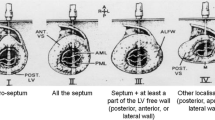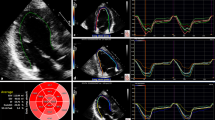Abstract
Treatment of overt form of hypertrophic cardiomyopathy (HCM) is often unsuccessful. Efforts are focused on a possible early identification in order to prevent or delaying the development of hypertrophy. Our aim was to find an echocardiographic marker able to distinguish mutation carriers without left ventricular hypertrophy (LVH) from healthy subjects. We evaluated 28 patients, members of eight families. Three types of mutation were recognized: MYBPC3 (five families), MYH7 (two families) and TNNT2 (one family). According to genetic (G) and phenotypic (Ph) features, patients were divided in three groups: Group A (10 patients), mutation carriers with LVH (G+/Ph+); Group B (9 patients), mutation carriers without LVH (G+/Ph−); Group C (9 patients), healthy subjects (G−/Ph−). Echocardiography examination was performed acquiring standard 2D, DTI and 2D-strain imaging. Global longitudinal strain (GLS) and global radial strain (GRS) at basal and mid-level were measured. GRS was significantly different between group B and C at basal level (32.18% ± 9.6 vs. 44.59% ± 12.67 respectively; p-value < 0.0001). In basal posterior and basal inferior segments this difference was particularly evident. ROC curves showed for both the involved segments good AUCs (0.931 and 0.861 for basal posterior and inferior GRS respectively) with the best predictive cut-off for basal posterior GRS at 43.65%, while it was 38.4% for basal inferior GRS. Conversely, GLS values were similar in the three group. 2D longitudinal strain is a valid technique to study HCM. Radial strain and particularly basal posterior and inferior segmental reduction could be able to identify mutation carriers in a pre-clinical phase of disease.





Similar content being viewed by others
References
Teare D (1958) Asymmetrical hypertrophy of the heart in young adult. Br Heart J 20:1–8
Maron BJ, Ommen SR, Semsarian C, Spirito P, Olivotto J, Maron MS (2014) Hypertrophic Cardiomyopathy Present and future with translation into contemporary cardiovascular medicine. J Am Coll Cardiol 64:83–99
Ho CY, McMurray J, Cirino AL, Colan SD, Day SM, Desai AS, for the VANISH trial investigators, and executive committee, et al (2017) The design of the valsartan for attenuating disease evolution in early sarcomeric hypertrophic cardiomyopathy (VANISH) trial. Am Heart J 187:145–155
Ho CY, Charron P, Richard P, Girolami F, Van Spaendonck-Zwarts KY, Pinto Y (2015) Genetic advances in sarcomeric cardiomyopathies: state of the art. Cardiovasc Res 105:397–408
Brouwer WP, Germans T, Head MC, Van der Welden J, Heymans MW, Christiaans I et al (2012) Multiple myocardial crypts on modified long-axis view are a specific finding in pre-hypertrophic HCM mutation carriers. Eur Hear J Cardiovasc Imaging 13:292–297
Germans T, Wilde AAM, Dijkmans PA, Chai W, Kamp O, Pinto YM et al (2006) Structural abnormalities of the inferoseptal left ventricular wall detected by cardiac magnetic resonance imaging in carriers of hypertrophic cardiomyopathy mutations. J Am Coll Cardiol 48(12):2518–2523
Peyrou J, Reant P, Reynaud A, Cornolle C, Dijos M, Rooryck-Thambo C et al (2016) Morphological an functional abnormalities pattern in hypertrophy-free HCM mutation carriers detected with echocardiography. Int J Cardiovasc Imaging 32(9):1379–1389
Smiseth OA, Torp H, Opdahl A, Haugaa KH, Urheim S (2016) Myocardial strain imaging: how useful is it in clinical decision making? Eur Heart J 37:1196–1207
Baudry G, Mansencal N, Reynaud A, Richard P, Dubourg O, Komajda M, Isnard R, Réant P, Charron P (2019) Global and regional echocardiographic strain to assess the early phase of hypertrophic cardiomyopathy due to sarcomeric mutations. Eur Heart J Cardiovasc Imaging https://doi.org/10.1093/ehjci/jez084
Voilliot D, Huttin O, Hammache N, Filippetti L, Vaugrenard T, Aliot E, Sadoul N, Juillière Y, Selton-Suty C (2015) Impact of global and segmental hypertrophy on two-dimensional strain derived from three-dimensional echocardiography in hypertrophic cardiomyopathy: comparison with healthy subjects. J Am Soc Echocardiogr. 28(9):1093–1102
Sun JP, Xu TY, Ni XD, Yang XS, Hu JL, Wang SC, Li Y, Bahler RC, Wang JG (2019) Echocardiographic strain in hypertrophic cardiomyopathy and hypertensive left ventricular hypertrophy. Echocardiography. 36(2):257–265
Shetty R, Samanth J, Nayak K, Sarang A, Thakkar A (2014) Evaluation of subtle left ventricular systolic abnormalities in adult patients with hypertrophic cardiomyopathy. J Clin Diagn Res 8(12):MC0–MC09
Serri K, Reant P, Lafitte M, Berhouet M, Le Bouffos V, Roudaut R, Lafitte S (2006) Global and regional myocardial function quantification by two-dimensional strain: application in hypertrophic cardiomyopathy. J Am Coll Cardiol. 47(6):1175–1181
Schnell F, Matelot D, Daudin M, Kervio G, Mabo P, Carré F, Donal E (2017) Mechanical dispersion by strain echocardiography: a novel tool to diagnose hypertrophic cardiomyopathy in athletes. J Am Soc Echocardiogr. 30(3):251–261
Elliott P, Anastasakis A, Borger M, Borggrefe M, Cecchi F, Charron P et al (2014) ESC Guidelines on diagnosis and management of hypertrophic cardiomyopathy. Eur Heart J 35:2733–2779
Lang R, Badano L, Mor-Avi V, Afilalo J, Armstrong A, Ernande L et al (2015) Recommendations for cardiac chamber quantifications by echocardiography in adults: an update from american society of echocardiography and the European Association of cardiovascular Imaging. Eur Heart Cardiovasc Imaging 16:233–271
Nagueh S, Smiseth O, Appleton C, Byrd B, Dokainish H, Edvardsen T et al (2016) Recommendations for the evaluation of left ventricular diastolic function by echocardiography. An update from the American Society of Echocardiography and the European Association of Cardiovascular Imaging. Eur Heart J Cardiovasc Imaging 17(12):1321–1360
De S, Borowski AG, Wang H, Nye L, Xin B, Thomas JD, Tang WH (2011) Subclinical echocardiographic abnormalities in phenotype-negative carriers of myosin-binding protein C3 gene mutation for hypertrophic cardiomyopathy. Am Heart J 162(2):262–267
Peyrou J, Réant P, Reynaud A, Cornolle C, Dijos M, Rooryck-Thambo C, Landelle M, Montaudon M, Laurent F, Roudaut R, Lafitte S (2016) Morphological and functional abnormalities pattern in hypertrophy-free HCM mutation carriers detected with echocardiography. Int J Cardiovasc Imaging. 32(9):1379–1389
Yiu KH, Atsma DE, Delgado V, Ng AC, Witkowski TG, Ewe SH, Auger D, Holman ER, van Mil AM, Breuning MH, Tse HF, Bax JJ, Schalij MJ, Marsan NA (2012) Myocardial structural alteration and systolic dysfunction in preclinical hypertrophic cardiomyopathy mutation carriers. PLoS ONE 7(5):e36115
Ho CY, Carlsen C, Thune JJ, Havndrup O, Bundgaard H, Farrohi F, Rivero J, Cirino AL, Andersen PS, Christiansen M, Maron BJ, Orav EJ, Køber L (2009) Echocardiographic strain imaging to assess early and late consequences of sarcomere mutations in hypertrophic cardiomyopathy. Circ Cardiovasc Genet. 2(4):314–321
Esposito R, Galderisi M, Santoro C, Imbriaco M, Riccio E et al (2019) Prominent longitudinal strain reduction of left ventricular basal segments in treatment-naive Anderson–Fabry disease patients. Eur Heart J Cardiovasc Imaging 20:438–445
Ho CY, Carlsen C, Thune JJ, Havndrup O, Bundgaard H, Farrohi F et al (2009) Echocardiographic strain imaging to assess early and late consequences of sarcomere mutations in hypertrophic cardiomyopathy. Circ Cardiovasc Genet 2:314–321
Nagueh S, McFalls J, Meyer D, Hill R, Zoghbi WA, Tam JW et al (2003) Tissue Doppler imaging predicts the development of hypertrophic cardiomyopathy in subjects with subclinical disease. Circulation 108:395–398
Kobayashi T, Popovic Z, Bhonsale A, Smedira NG, Tan C, Rodriguez ER et al (2013) Association between septal strain rate and histopathology in symptomatic hyper-trophic cardiomyopathy patients undergoing septal myectomy. Am Heart J 166:503–511
Haland TF, Almaas VM, Hasselberg NE, Saberniak J et al (2016) Strain echocardiography is related to fibrosis and ventricular arrhythmias in hypertrophic cardiomyopathy. Eur Heart J Cardiovasc Imaging 17:613–621
Candan O, Gecmen C, Bayam E, Guner A et al (2017) Mechanical dispersion and global longitudinal strain by speckle tracking echocardiography: predictors of appropriate implantable cardioverter defibrillator therapy in hypertrophic cardiomyopathy. Echocardiography 34:835–842
Acknowledgements
The Authors would like to thank the patients who participated in this study. Their willingness and their enthusiasm encouraged us throughout our work.
Author information
Authors and Affiliations
Corresponding author
Ethics declarations
Conflict of interest
The authors report no specific funding in relation to this research and no conflicts of interest to disclose.
Additional information
Publisher's Note
Springer Nature remains neutral with regard to jurisdictional claims in published maps and institutional affiliations.
Rights and permissions
About this article
Cite this article
Santambrogio, G.M., Maloberti, A., Vallerio, P. et al. Could two-dimensional radial strain be considered as a novel tool to identify pre-clinical hypertrophic cardiomyopathy mutation carriers?. Int J Cardiovasc Imaging 35, 2167–2175 (2019). https://doi.org/10.1007/s10554-019-01668-9
Received:
Accepted:
Published:
Issue Date:
DOI: https://doi.org/10.1007/s10554-019-01668-9




